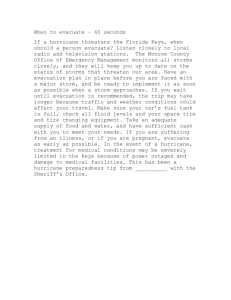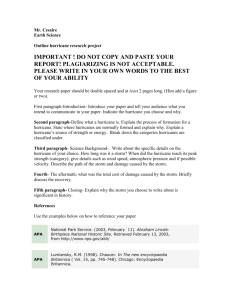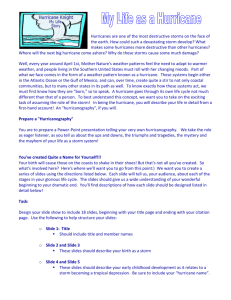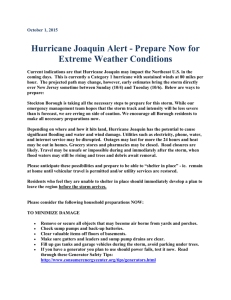Tropical Cyclone Intensity Estimation using Eigenanalysis Techniques Tim Douglas
advertisement
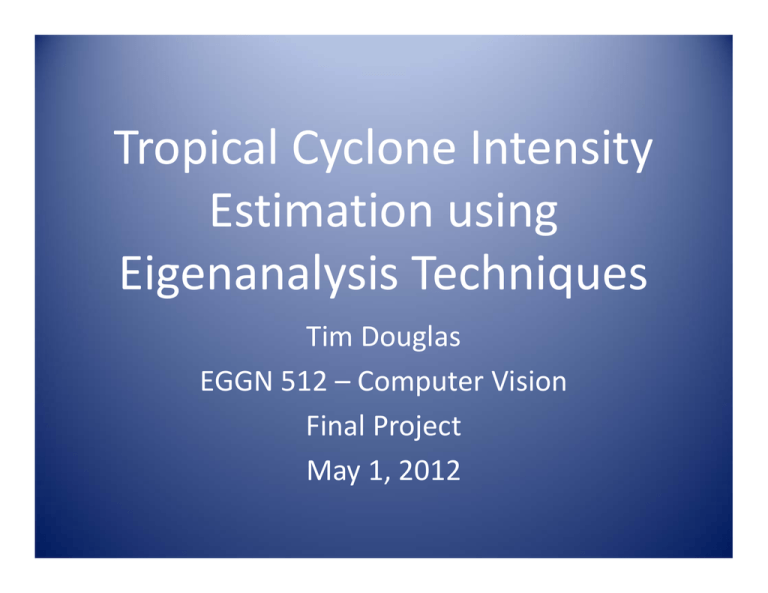
Tropical Cyclone Intensity Estimation using Eigenanalysis Techniques Tim Douglas EGGN 512 – Computer Vision Final Project May 1, 2012 Outline • • • • • • • What is the Dvorak Intensity Estimation? Definition of Intensity Estimation Algorithm Implementation of Eigenanalysis Techniques Eigenanalysis – Conceptually & Mathematically Realization of Eigenanalysis in MATLAB Test Results and Model Performance Conclusions Dvorak Intensity Classification • 1950’s: Development of visible satellite imaging for weather forecasting and analysis. • 1960’s: Attempts to estimate cyclone wind speed purely from storm diameter.1 • 1970’s: Meteorologist Vernon Dvorak develops a satellite‐based intensity estimation technique.2 – – – – – Eye structure (if one exists) Curved cloud banding Relative storm density and structure Central overcast density Relative intensity value (CI = T) 1Hubert, Lester F., and Timchalk, Andrew. “Estimating Hurricane Wind Speeds from Satellite Pictures.” Monthly Weather Review, Vol. 97, No.5, pp. 382‐383, 1969. 2Velden, Christopher; et al. “The Dvorak Tropical Cyclone Intensity Estimation Technique.” American Meteorological Society, pp. 1198‐1210, Sept. 2006. Implementation of Eigenanalysis (1) • Analyze database of archived storm satellite images over range of intensity values and establish pattern.3 Most common intensities range from T = 3.5 to 7.5. All images 480x480 and span same degrees of latitude/longitude. Gamma transform followed by binary thresholding applied to eliminate differences in lighting and hue of satellite images. • Eigenanalysis employed to determine relative structures of storms within database to form basis manifold. Database of 25 storms of known intensities; rotate each image three times (90 degrees each) to enhance rotational symmetry. Project test storm image onto basis manifold. Estimate intensity based on weighted sum of four nearest neighbors in manifold to location of projection. 3All images archived by National Hurricane Center (NHC), Online: www.nhc.noaa.gov Implementation of Eigenanalysis (2) • A database of known storms is used to correlate a test storm against for identification. • Perform principle component analysis (PCA) via the singular value decomposition (SVD) of the known storm database matrix A. • Columns of U represent the “eigencanes” of the database. • Project test storm xt onto span(U). – Coefficients are: bt = UTxt • Also compute coefficients for all images in the database. • Euclidean distance between coefficients quantifies correlation. A = U D VT ATA (nxn) is small. Eigenvectors of ATA are the columns of V. Eigenvalues of ATA are the diagonal entries in D. U = A V D‐1 Columns of U are the principle components of A and eigenvectors of AAT. Only keep most significant principle components in U. Eigenanalysis – Conceptually • “Manifold” refers to multidimensional vector space where principal components of database live (i.e. “eigenspace”). • Test storm image lives somewhere outside of manifold. • Compute coefficients of orthogonal projection of test image onto manifold – error is DFSS (distance from storm space) • Euclidean distance to neighbors is DISS (distance in storm space) Eigenanalysis – Mathematically Known Storm 480x480 Vectorized Known Storm 230400x1 Database 230400x100 Eigencanes 230400x20 Coefficients 20x100 Database Construction – MATLAB First Eigencane Second Eigencane Third Eigencane Details of Analysis in MATLAB (1) Hurricane Norbert, T = 6.0 Test Image. DFKSS=2.220e+002 Details of Analysis – MATLAB (2) Projection of test storm in known storm space Closest Match: Storm HIke653.jpg. DIKSS=6.506e+001 Second Match: Storm HJeanne552.jpg. DIKSS=7.471e+001 Third Match: Storm HIke652.jpg. DIKSS=9.011e+001 Fourth Match: Storm TSFrances353.jpg. DIKSS=9.089e+001 Ranked Matches: 6.5, 5.5, 6.5, 3.5 Estimated Intensity Weighted Sum: 40%, 30%, 20%, 10% Estimated Intensity: T = 5.9 Test Results and Model Performance Storm Name NHC Dvorak Classification Model Prediction Absolute Error 7.5 7.45 0.05 7 7.3 0.3 Hurricane Edouard 6.5 6.5 0 Hurricane Iniki 6.5 6.5 0 Hurricane Marilyn 6 5.9 0.1 Hurricane Norbert 6 5.9 0.1 Hurricane Bertha 5.5 4.85 0.65 Hurricane Charley 5.5 5.9 0.4 Hurricane Roxanne 5.5 5.5 0 Hurricane Carlos 5 5.55 0.55 Hurricane Gert 5 5.6 0.6 Hurricane Frances 4.5 5 0.5 Hurricane Lane 4.5 5.25 0.75 Hurricane Nicole Tropical Storm Chantal 4.5 4 4.4 3.9 0.1 0.1 Hurricane Gilbert Hurricane Ioke Average Error Error Variance 0.28 0.0676 Conclusions • Dvorak intensity representation provides an accurate estimation of the strength of tropical cyclones. • Basic eigenanalysis methods implemented in MATLAB – Form database of known storms spanning all intensities – Project unknown storm onto basis manifold – Four nearest neighbors to projection used in estimation • Computed using Euclidean distance between coefficients in eigenspace • Model Performance – – – – Predicts Dvorak intensity to within +/‐ 0.75 of actual. Using region properties (EGGN 510): Average error was 0.375. Weaker storms more difficult due to poorly correlated structure. Future Improvements: Multiple images of same storm over time, larger database, more precise/consistent preconditioning. Questions???



